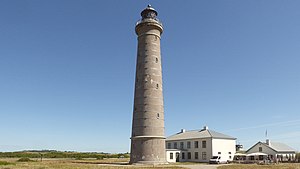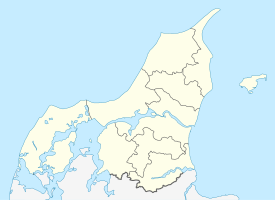Skagen Fyr
| Skagen Fyr | ||
|---|---|---|
| Skagen Fyr (1858) - Southwest view from the lighthouse | ||
| Place: | Skagens Gren (headland Grenen) | |
| Location: | 3500 m NE of Skagen | |
| Geographical location: | 57 ° 44 '7.8 " N , 10 ° 37' 48.7" E | |
| Fire height : | 44 m | |
|
|
||
| Identifier : | Fl W 4 sec | |
| Scope knows: | 20 nm (37 km ) | |
| Optics: | 5-lens rotating optics f = 700mm (Fresnel) | |
| Operating mode: | 400 W LP sodium vapor lamp | |
| Function: | Landmark | |
| Construction time: | 1856-1858 | |
| Operating time: | from 1858 | |
| International ordinal number: | C 0002 | |
The Danish lighthouse Skagen Fyr , which was popularly known as "Det Grå Fyr" (the gray lighthouse), was built from 1856 during the reign of the Danish King Frederick VII according to plans by the architect Niels Sigfred Nebelong in just under three years of construction. The tower is located near the village of Skagen in North Jutland in the east of the Skagen Odde landscape. It is currently the second tallest Danish lighthouse after the one meter higher lighthouse Dueodde Fyr (built until 1962).
history
Danish beacons in Skagen go back to 1561 when the first fireplace with an open fire in a basket (Danish: "papegøjefyr" , parrot fire ) was used to protect shipping on the northeast coast of Jutland . In 1627 the Skagen Vippefyr (Wippfeuer) was built. A coal fire was raised to a height using a wooden seesaw to make it visible from a greater distance. The Vippefyr was replaced in 1747 by an octagonal masonry tower planned by the architect Philip de Lange, over 20 meters high , which served as a lighthouse with its beacon until 1858 and was later called Det Hvide Fyr (white lighthouse) due to its white color .
The current lighthouse Skagen Fyr is located approximately 3.5 kilometers northeast of the municipality of Skagen. It was planned by the architect and Copenhagen city builder Niels Sigfred Nebelong , after which construction work could begin in 1856.
Building
For the construction of the structure it was necessary to make the heavily sandy subsoil stable. This problem was solved by using a kind of pile foundation in the sandy soil, which consisted of more than 420 round wooden piles made of larch wood. For the architect who studied, who was on educational trips abroad from 1839 to 1843, this foundation construction method was nothing new; a challenge, however, was the planned tower height of 46 meters in total, which meant that the tallest structure in Denmark was being erected at the time of construction. The rising brick building gives the tower its red-brown-gray color and tapers conically with increasing height. A ring anchor made of natural stone is installed in the lower part; above it are at uneven intervals 13 tensile steel ring anchors on the outer wall side of the tower.
Inside the tower, a staircase leads over 210 steps to the upper tower platform and the lantern of the lighthouse. The tower platform is accessible and secured with a steel railing. The lantern housing is glazed and, including the roof hood, is supported by metal bars arranged diagonally or in a diamond shape. After construction began in 1856, the inauguration and commissioning took place on November 1, 1858. From 2008 Skagen fyrtårn was renovated and in 2013 it was transferred to a new operator.
Lantern
Initially, a kerosene lamp with several wicks behind an immovable lens was used as a beacon . As early as 1905, the lantern complex was converted for a more modern beacon construction. An approx. 2 tonne, five-lens optic from the Paris company Barbier, Benard et Turenne was installed on a built-in slewing ring . The optics construction was moved by a mechanical rotating mechanism . The petroleum light source was replaced in 1947 by an electric lamp with 1000 watts of power, which was later replaced by a 1500 watt incandescent lamp . In the meantime, the movable optics also received an electric motor drive. In 2004 the light source was switched to a 400 watt sodium vapor lamp . The current light range is 20 nautical miles with a flash sequence of four seconds.
operator
The lighthouse operation was initially the responsibility of the client, the Royal Danish Maritime Administration, and later the Danish Maritime Authority in Copenhagen. In 2013 the lighthouse was transferred to Realdania , a form of foundation that strives to preserve historically significant values in Denmark. An ornithological center for bird watching has been established at the tower, which works with the Danish Nature Agency and the Danish Association for Ornithology .
Publicity
The Skagen lighthouse is open to visitors at different times in summer than in winter (until 2018 between 10 a.m. and 4 p.m., longer in summer).
Web links
- Leuchttuerme.net - Portrait Skagen (Grenen) i Skagen. In: Leuchttuerme.net.
- Det Grå Fyr. In: skagensiden.dk. (Danish).



